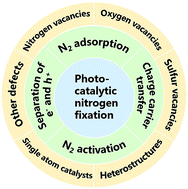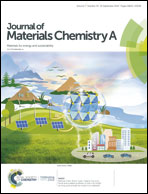Photocatalytic nitrogen fixation: the role of defects in photocatalysts
Abstract
Nitrogen-containing compounds like ammonia (NH3) and nitrates are essential materials for modern fertilizers, medicines, fibers, explosives, etc., which are closely relevant to the development of human society. However, the widely used conventional Haber–Bosh process for the synthesis of ammonia requires high temperature and energy over a long period of time. In recent decades, the photocatalytic nitrogen fixation process has been demonstrated to be a low-energy consuming and sustainable approach to produce nitrogen-containing compounds, which has attracted extensive attention. Currently, the strategies for the development of efficient photocatalysts for nitrogen fixation are primarily concentrated on creating active sites by introducing defects into the photocatalysts to activate the adsorbed N2 by weakening the N![[triple bond, length as m-dash]](https://www.rsc.org/images/entities/char_e002.gif) N triple bond, facilitate the charge separation and accelerate charge carrier transfer from photocatalysts to the adsorbed reactants. In this review, we summarize the recent developments in photocatalysts with various defects for nitrogen fixation. First, we discuss the reaction mechanisms of the photocatalytic nitrogen fixation process. Second, several categories of defects corresponding to their related element compositions are investigated. Then, the theoretical and the computational survey on defects in nitrogen fixation photocatalysts are also presented. Finally, the existing challenges, opportunities and future prospects in this burgeoning area are discussed.
N triple bond, facilitate the charge separation and accelerate charge carrier transfer from photocatalysts to the adsorbed reactants. In this review, we summarize the recent developments in photocatalysts with various defects for nitrogen fixation. First, we discuss the reaction mechanisms of the photocatalytic nitrogen fixation process. Second, several categories of defects corresponding to their related element compositions are investigated. Then, the theoretical and the computational survey on defects in nitrogen fixation photocatalysts are also presented. Finally, the existing challenges, opportunities and future prospects in this burgeoning area are discussed.

- This article is part of the themed collection: Recent Review Articles


 Please wait while we load your content...
Please wait while we load your content...